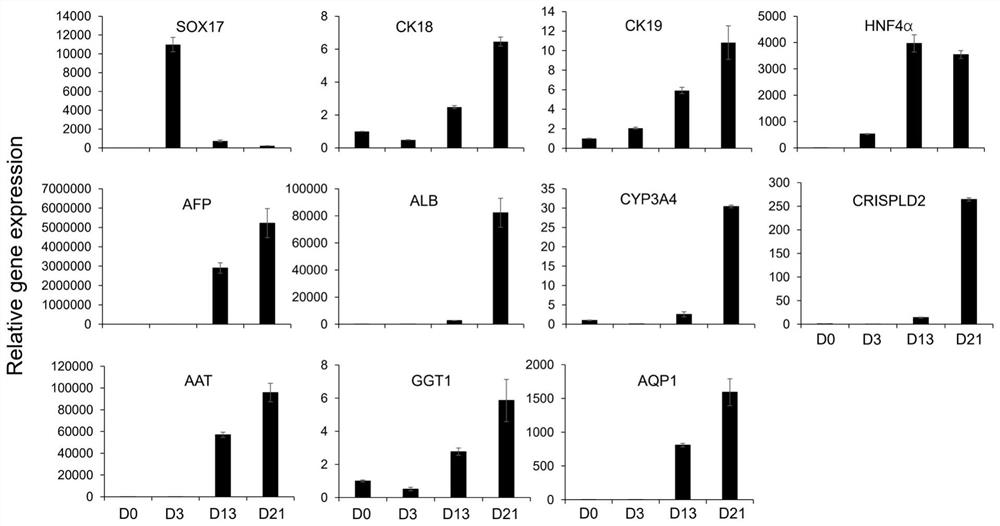Method for differentiating and inducing stem cells into hepatocytes
A stem cell differentiation and hepatocyte technology, applied in the field of biomedicine, can solve the problems of weak function of hepatocytes, lack of cells in stem cells, difficulty in harvesting a large number of cells, etc., and achieve the effect of low cost and stable culture environment
- Summary
- Abstract
- Description
- Claims
- Application Information
AI Technical Summary
Problems solved by technology
Method used
Image
Examples
Embodiment 1
[0069] Example 1 Human embryonic stem cell (HESCS) recovery
[0070] MATRIGEL (original solution) was taken in advance, placed in ice, then diluted 100 times with pre-cooled DMEM / F12 medium, add 1 mL to join the six-well plate, gently shake well, full hole The bottom of the plate. The six-hole plate is placed in a 37 ° C incubator (about 30 minutes), spare. MTESR1 human embryonic stem cell culture medium was taken from 4 ° C refrigerator, and the room temperature was placed for about 10 minutes, and 75% ethanol was transferred into the ultra-clean station. The H9 cells are removed from the liquid nitrogen freeze box, rapidly transferred into a 37 ° C water bath, gently shake, melted to the frozen contained small ice 即 即, 75% ethanol is transferred into the ultra-clean station. Carefully transfer cells to 15 ml of centrifuge tube, and approvressed 5 ml of MTESR1 medium from slow until 5 minutes, 1000 rock, centrifuged for 5 minutes, carefully discard the supernatant, adding the M...
Embodiment 2
[0071] Example 2, cultivation, passage, and freezing of human embryonic stem cells
[0072] The cell state should be observed before replacing fresh mtessr1 medium daily, if a large amount of dead cells are found to float the medium (poor in the cell state of the rigidity), the medium is discarded, and the preheating DMEM / F12 is easily washed once, discard DMEM / F12, add fresh MTESR1 medium, which is placed in a 37 ° C incubator to continue culture. The cells grow from about 3 to 5 days to 80% conventional, and the human embryonic stem cell clone is obvious, and the edge is smooth.
[0073] The cell passage, according to the experimental need to be used in advance by Matrigel package by the culture plate (1: 5 to 1:10 ratio), with the pre-package by Matrigel, shake well in a 37 ° C incubation. The cells were washed twice with DMEM / F12, and 1 mLACCutase digestive solution was added per well, and was placed in a 37 ° C incubator for 3 to 5 minutes. Invert the microscope every 2...
Embodiment 3
[0075] Example III, human embryonic stem cell differentiation into a liver spheroid (Liver spheroid)
[0076] In this example, the type endoderm-induced medium is purchased from Fuyuan (Shanghai) Biotechnology Co., Ltd., the item number RC200123.
[0077] (1) Try cells were cultured in a stereotype induced endoderm induced in Activin A and CHIR99021.
[0078] Divided human embryonic stem cells grown to about 90% of the converged human embryonic stem cells were induced. Human embryonic stem cells grown to approximately 90% were placed twice with preheating RPMI1640 base medium, and the added endoderm-induced medium containing 100 ng / ml Activin A and 1 to 2 μm CHIR99021 was added, and liquidated for a total of 3 days. On day 4, the cells were laminated twice with AdvancedDMEM / F12 medium, and the amount of intuntase digestive fluid digestion was added 3 to 5 minutes, collecting cells, 1000 rpm for 5 minutes, abandoned, collecting cells.
[0079] (2) The cells obtained in the Adva...
PUM
 Login to View More
Login to View More Abstract
Description
Claims
Application Information
 Login to View More
Login to View More - R&D
- Intellectual Property
- Life Sciences
- Materials
- Tech Scout
- Unparalleled Data Quality
- Higher Quality Content
- 60% Fewer Hallucinations
Browse by: Latest US Patents, China's latest patents, Technical Efficacy Thesaurus, Application Domain, Technology Topic, Popular Technical Reports.
© 2025 PatSnap. All rights reserved.Legal|Privacy policy|Modern Slavery Act Transparency Statement|Sitemap|About US| Contact US: help@patsnap.com



